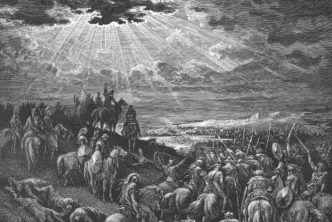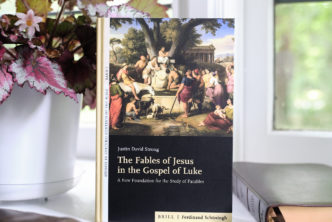
At long last, Logos Bible Software (Faithlife.com) has managed to integrate an outstanding resource, “Texte aus der Umwelt des Alten Testaments” (TUAT), into its electronic library. One meter of shelf space in printed books has become available on PCs, laptops, or smartphones, to be searched from a computer, and to be copied and cited for one’s own research.
What Exactly Is TUAT?
“Texte aus der Umwelt des Alten Testaments” (commonly abbreviated: TUAT, the English equivalent is “Texts from the (Cultural) Context of the Old Testament”) is an indispensible standard reference for deeper study of the Bible. As a collection of source texts, TUAT brings light to the societies, cultures, and religions of the Ancient Near East – the setting in which the Bible came into existence as “God’s Word in Man’s Word”. In order to more deeply understand the manifold human encounters with God that were incorporated into the epic work known as the “Bible” (especially the Hebrew Bible, called the “Old Testament” in Christian reception), it is useful, perhaps even necessary, to broaden one’s horizon and dive into the fascinating world of antiquity. Beyond biblical studies, TUAT has long been recognized as a reference resource in disciplines such as Ancient Near Eastern (ANE) Studies, Egyptology, as well as Historiography of Religion and the Cultural History of the Ancient Near East.
“Texte aus der Umwelt des Alten Testaments” makes available to the German language an enormous corpus of texts from the ancient cultural environment of the Bible. This as yet incomplete collection features both source texts often related to the Hebrew Bible/Old Testament in various ways with some that are lesser known, all translated and annotated by experts in their respective disciplines. Due to its enormous scope, this collection facilitates intercultural comparisons in a unique way. And it is a major coup that such a valuable body of texts was integrated into a software intended to get to the bottom of the biblical text.
The TUAT collection includes texts ranging from the 25th century BC to the 3rd century AD, from Egypt and the Hittite Empire, from Akkad and Sumer, Alalakh, from Old South Arabian, from North Arabia and Iran; Aramaic texts, texts from Canaan and Mari, from Moab, Phoenicia, and Ugarit; and finally, Greek texts from Egypt. This makes TUAT the most important and most comprehensive German-language collection of texts that shed light on the historical setting of the Old Testament, its religious, social, and economic history, as well as its political and legal context. Modern readers will gain insight into the linguistic and cultural encyclopedia in which the ideas and texts of the Bible originated. A comparable English resource is “The Context of Scripture” (CoS, 4 vols., Leiden: Brill, 1997–2016), edited by William W. Hallo and K. Lawson Younger. But CoS is far less extensive, and only the first three volumes are available electronically at this point.
What Is The Internal Structure Of TUAT?
TUAT is comprised of two series: The “Old Series” (“Alte Folge”, TUAT-AF) was edited by Otto Kaiser from 1982 to 1997. It was first released in the form of fascicles, which were later combined into three volumes (I-III). A supplemental volume (TUAT-E) was published in 2001. The “New Series” (“Neue Folge”, TUAT-NF) was first edited by Bernd Janowski and Gernot Wilhelm, later by Bernd Janowski and Daniel Schwemer starting with volume 5. Eight volumes have been released so far, with a ninth volume addressing culture of knowledge (“Wissenskultur”) in the works. All twelve volumes of the Old and New Series are now available digitally, which will look like this in your Logos library:
How Is TUAT Commonly Cited And Read?
TUAT is commonly cited by volume and page number. For example, the beginning of W.G. Lambert’s treatise on the Babylonian epic Enuma Elish can be referenced as “TUAT-AF III, 565”. Unfortunately, the volume abbreviations are not indicated in the Logos library. The following outline can help you find a given volume in your library, or quote passages in the established format:
| TUAT Volume Moniker | Volume Title |
| TUAT-AF I | Rechts- und Wirtschaftsurkunden – Historisch-chronologische Texte |
| TUAT-AF II | Religiöse Texte |
| TUAT-AF III | Weisheitstexte, Mythen, Epen |
| TUAT-AF E | Ergänzungslieferung |
| TUAT-NF 1 | Texte zum Rechts- und Wirtschaftsleben |
| TUAT-NF 2 | Staatsverträge, Herrscherinschriften und andere Dokumente zur politischen Geschichte |
| TUAT-NF 3 | Briefe |
| TUAT-NF 4 | Omina, Orakel, Rituale und Beschwörungen |
| TUAT-NF 5 | Texte zur Heilkunde |
| TUAT-NF 6 | Grab-, Sarg-, Bau- und Votivinschriften |
| TUAT-NF 7 | Hymnen, Klagelieder und Gebete |
| TUAT-NF 8 | Weisheitstexte, Mythen und Epen |
A note from the German Logos product management team: This review is based on a pre-release version of the Logos edition. The widely used volume abbreviations will be available as abbreviated titles in the final release. While at first you won’t be able to actually navigate the resource by this common reference format, we’re hoping to add this feature by the fall of 2020.
A look at the various volume titles offers clues on how to approach TUAT in practice: by literary genre (at least roughly). In addition, the texts in each volume are sorted by region and language.
Whenever you open a volume for the first time, I recommend that you enable the Page numbers (Seitenzahlen anzeigen) Visual Filter (click on the three dots forming a triangle):
How To Search Within TUAT
TUAT can be searched in the same way as any other Logos resource. A search will ignore German umlauts, i.e. “Vater” will include results for “Väter” and “Vaters”, “Gott” will include “Götter”, but “lösen” (Engl. “to solve, loosen”) will yield results for “Lose” (“lots”) and “lose” (“loose”). Conveniently, you can choose to include footnotes in a search (this setting is accessible through Alle Textebenen > Felder search), and it will ignore diacritical marks or parentheses.
One way to work with TUAT in Logos is to set up a custom Layout “TUAT” that features all twelve resources, sorted according to the chart shown above. This will make it easier to find the volume you’re looking for (I-III, E, 1-8). In the following example, I have arranged TUAT-AF (volumes I-III and the supplemental volume) on the left and the eight volumes of TUAT-NF on the right in the intended sequence:
Working with a Layout offers an additional benefit: In a book search, you can now choose All Open Resources to search all twelve volumes at once. In the following example, a search for “Weihrauch” (frankincense) yielded 167 results. The results view mode nach Werk (“by resource”) lets you survey the number occurrences in each and every volume, and by clicking on the small triangle left of the volume title, you can preview each result (as depicted for the Supplemental Volume below). A click on the section title displayed in blue (in the example: Der Regierungsbericht des Nastasen) will open the resource with your search term highlighted.
For the following example, I expanded the 38 occurrences in the volume “Texte zur Heilkunde” (“Medical Texts”) and clicked on the reference to Hautkrankheiten (skin diseases). This opened the full text of the reference in the panel on the right:
Instead of saving a Layout, you could also create a custom resource collection that includes all twelve resources. To do this, open the Tools menu and find Collections in the Library subsection. Create a new collection and name it something like “TUAT AF and NF.”
These remarkable search features reveal the immense advantage of the electronic TUAT edition in Logos Bible Software: a search like the one above, taking just fractions of seconds, would be impossible in a print edition – especially since the TUAT-NF volumes don’t even come with a subject index (perhaps in anticipation of an electronic edition). A word on pricing: The print edition of TUAT-NF currently goes for 149 EUR per volume. The Pre-Pub price for the entire electronic Logos edition (TUAT-AF and NF) is less than half of the total price of all eight printed volumes of TUAT-NF combined.
Are There Visual Differences Between TUAT-AF And TUAT-NF?
“Als oben die Himmel nicht benannt waren, unten die Erde mit Namen nicht ausgesprochen war, (da) war Apsû, der Erste, ihr Erzeuger, (und) Mummu Tiʾāmat, die sie alle gebar; …” – with these mysteriously murmured words, still familiar to some who acquired a degree in Theology, begins the epic Enûma Eliš, previously known as the “Babylonian Creation Epic”. But this designation is not entirely accurate, as only a small part of the work deals with the creation of the world. In 1994, W.G. Lambert presented a description and German translation (TUAT-AF III, visible on the left in the following screenshot). Karl Hecker had good reason to rework the German text for TUAT-NF 8 (“Weisheitstexte, Mythen und Epen”, TUAT-NF 8, S. 88-132). He titles his translation, “Marduks Aufstieg zum Herrn der Welt” (“Marduk’s Rise to Lord of the World”), a much better fit for the epic, which narrates not just the creation of the world, but chiefly how (and why) Marduk the local god of Babylon became the supreme god in the pantheon. Ancient Near Eastern Studies have made strides in the past decades, and new fragments of the text have come to light (Lambert’s Ausgangstext was from 1964); numerous new studies in several modern languages have been published.
And so it is more than justified that this significant Babylonian epic was republished in a new German translation in TUAT-NF 8 (on the right in the screenshot). Another thing you’ll notice in the screenshot is that the Logos edition goes so far as to adopt TUAT-NF’s appealing typography. The actual translation of the Ancient Near Eastern source text is set in sans serif type, whereas the editorial commentary and annotations are set in a serif typeface.
How Does TUAT Relate To The Bible?
TUAT does not concern itself with a “parallelomania” in an attempt to – for whatever reason – uncover parallels between the Bible and the literature of its ancient context at any cost. Most of TUAT is about expanding one’s horizon and making a (supposedly) lost world available in the German language. And that includes economic texts, (diplomatic) correspondence, but also legal or political texts that complement our perspective with further genres and establish any historical reconstruction on a broader foundation.
Of course, there are multiple texts that are particularly significant for the study of the Hebrew Bible. Let me list a few examples from TUAT-AF and TUAT-NF.
One very important find for the reconstruction of the history of Israel is a Moabite inscription by King Mesha of Moab (the so-called Mesha Stele), dating back to the 2nd half of the 9th century BC. This votive inscription, occasioned by the construction of a sanctuary, opens up a perspective on Israel from the outside in King Mesha’s self-praise. Among others, it references King Omri and his son (Ahab). TUAT-AF I, 646ff. features an introduction and translation by Hans-Peter Müller.
Another significant source for the religio-historical exploration of Israel’s concept(s) of God are the inscriptions from Kuntillet Ajrud, a settlement located on the road from Gaza to Eilat. The very short texts deal with the subject of “blessings” (blessings by God, human blessings through deities, human blessings and praise of a deity). They may be writing exercises.
Two aspects in particular become clear from these inscriptions: there are different regional manifestations of YHWH (of Teman and Samaria), and YHWH has a parhedros, a female partner, the goddess Ashera. It is disputed whether “his Ashera” is referring to a cult object or a female deity. TUAT-NF in particular clearly favors the “Goddess” interpretation. The inscriptions were edited both in TUAT-AF II, 561ff. (left) by Diethelm Conrad (1988) and in TUAT-NF 6, 314ff. (right) by Angelika Berlejung (2011). The inscription on pithos B may serve as an example:
Tombs in Ketef Hinnom in Jerusalem, discovered by Gabriel Barkay in 1979, yielded two tiny rolled-up silver scrolls. They are engraved with texts of blessing. These little silver scrolls were amulets worn every day. The texts on the amulets are very close to passages from the Bible. In particular, Deut 7:9, Neh 1:5, Dan 9:4 and especially Num 6:24-26 were identified. Once more, TUAT has published a German translation (A/KH 1 and B/KH 2) in both the Old Series (TUAT-AF II, 929ff, Diethelm Conrad, 1991) and the New Series (TUAT-NF 6, 311ff, Angelika Berlejung, 2011). The New Series edition chooses to display both texts (KH 1 und KH 2) synoptically. Furthermore, a comparison demonstrates that TUAT-NF presents and describes the texts with greater precision.
Conclusion
The electronic version of TUAT-AF and TUAT-NF, as it has now been compiled in Logos Bible Software, opens up this incredibly valuable standard reference resource in a whole new way. Digital search leads to new research opportunities previously unimagined. This is not just a boon for biblical exegesis and scholarly research of the Hebrew Bible/Old Testament. TUAT will also quickly prove to be an indispensable digital tool for Ancient Near Eastern Studies, Hittitology, Egyptology, Ugaritic Studies, as well as the comparative Religious and Cultural Studies of the Ancient Near East.




Does this collection contain any texts that are not available in an English translation?
Hi David, the TUAT series is in German, which is not available in English translation.
No, I meant, has anyone created a chart showing to what extent it overlaps with ANET/COS etc?
Yes, to my knowledge, several of the texts in this collection have not been published in any other modern language.
Thanks so much Ben!
So if I’m understanding this right TUAT is basically a giant reference collection of primary text resources translated into English?
if so how does it differ from resources like Outside the Bible, 3-volume set: Ancient Jewish Writings Related to Scripture, Writings From the Ancient World (16 vols.) and others like Context of Scripture? also what will the cost be if any?
Wie erzwinglich soll dieses Werk sein?
Es ist wichtig für Forschungszwecke. Fragen Sie andere Wissenschaftler, wie oft sie es für ihre Disziplin verwenden. Mit besten Grüßen, the Editor.
Moderation?